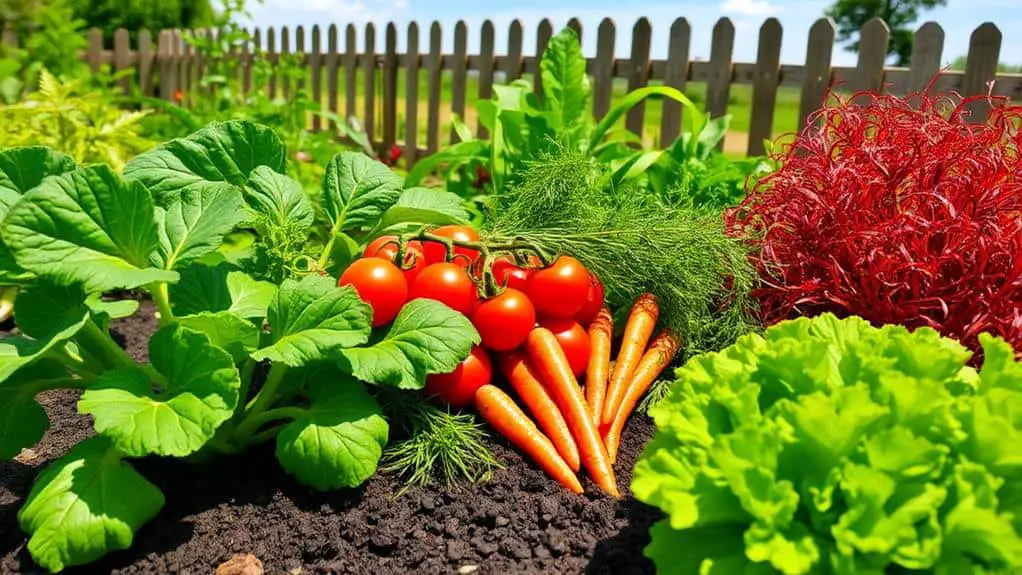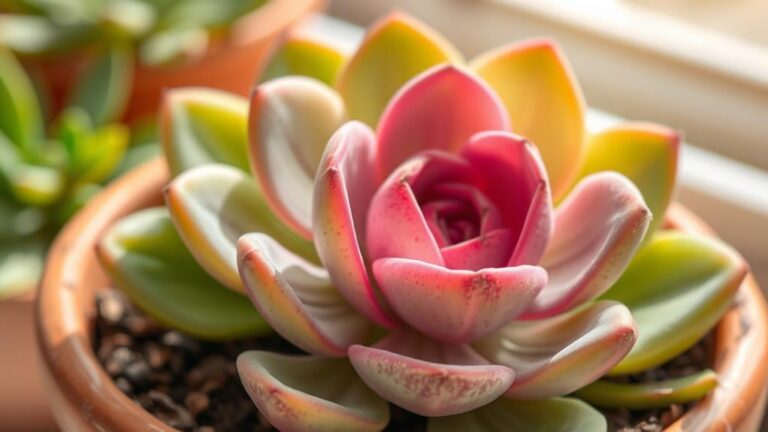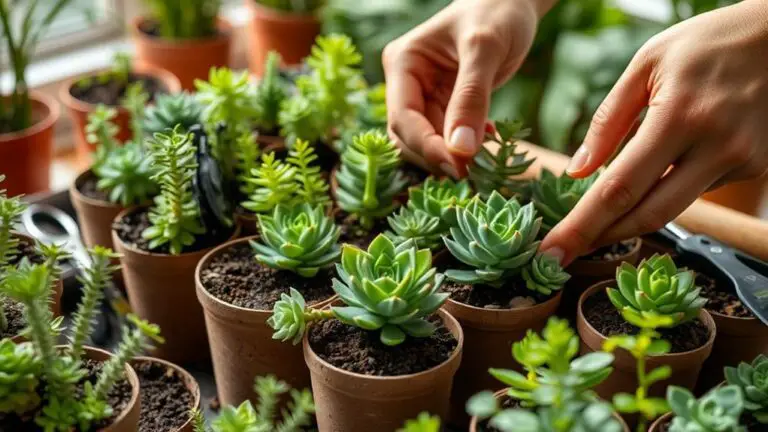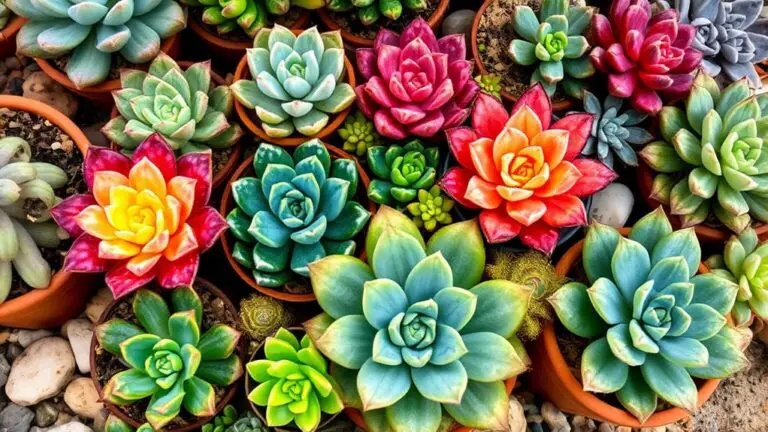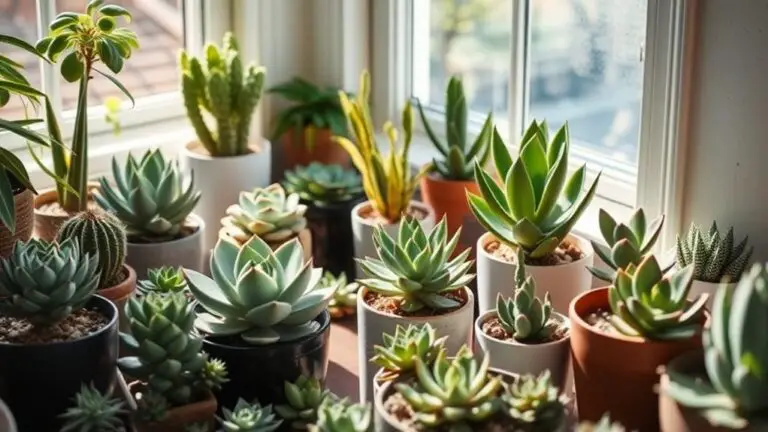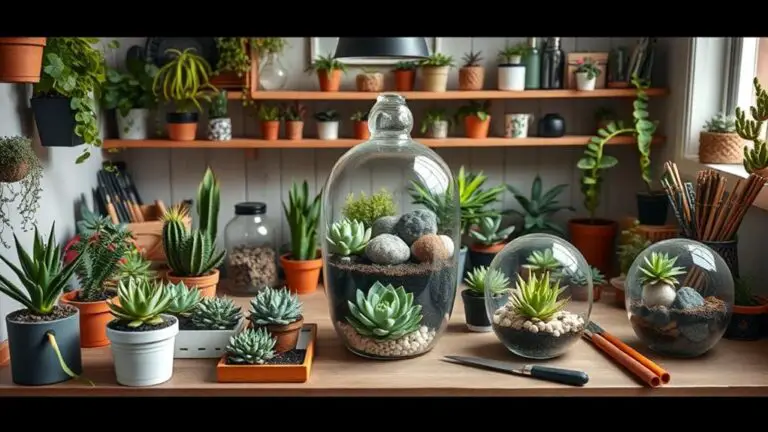15 Easy Vegetables to Grow for Beginner Gardeners
Starting a vegetable garden can seem intimidating, but you'll find that some vegetables are particularly easy to grow, even for beginners. Imagine harvesting crisp lettuce or crunchy radishes right from your backyard without much fuss. Green beans and carrots not only grow quickly but also add a burst of color to your meals. If you're looking to enrich your soil, peas are a great choice. Bell peppers and broccoli offer nutritional benefits, while garlic and spring onions can elevate your cooking. Curious about what makes these vegetables so beginner-friendly? Let's explore how each one can thrive in your garden.
Lettuce
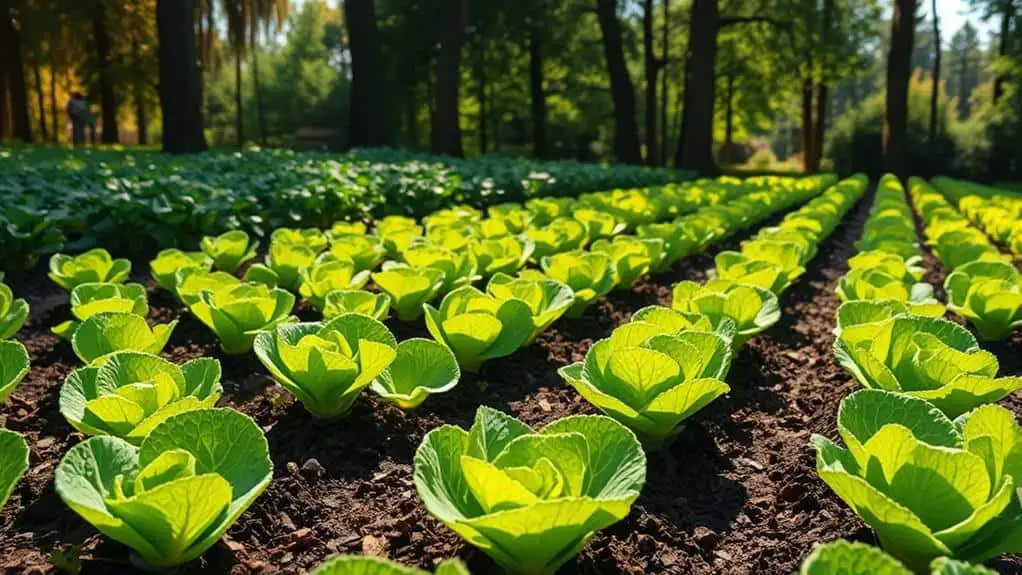
Lettuce is a fantastic choice for beginner gardeners because it thrives in cool temperatures and can be planted early in the spring, often tolerating light frost. This makes it a forgiving plant to start with, especially if you're new to gardening.
Lettuce needs well-drained soil to grow well, so verify your garden bed or container garden has good drainage. Space the seeds about 8-10 inches apart to guarantee proper airflow and growth.
One of the best things about growing lettuce is the quick results. Some leaf lettuce varieties can be ready for harvest in as little as 30 days after sowing. This is great for beginner gardeners enthusiastic to see their efforts pay off.
Plus, using the cut-and-come-again method allows you to harvest leaves multiple times throughout the season. Just snip off the outer leaves, and your plant will keep producing more.
If you don't have much space, don't worry. Lettuce grows well in containers, making it perfect for urban gardening.
With consistent moisture and proper care, you'll soon have fresh, tasty greens right at your fingertips. Enjoy the satisfaction of growing your own food!
Radishes
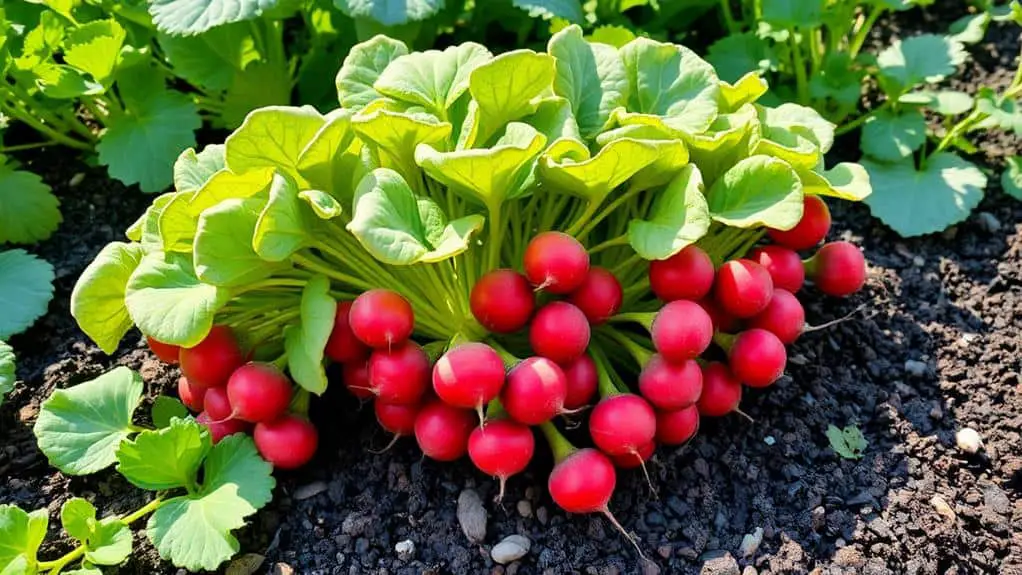
Among the easiest vegetables you can grow, radishes stand out due to their rapid growth and minimal maintenance requirements. Perfect for beginner gardeners, radishes are fast-growing, maturing in just 24 to 30 days from seed to harvest. This quick turnaround means you won't have to wait long to enjoy your fresh produce.
Radishes thrive in well-drained soil and prefer cooler temperatures, making early spring an ideal time to plant them. You can even plant a second crop in the fall. Their preference for cooler weather allows you to extend your gardening season, giving you more opportunities to grow and harvest these delightful veggies.
One of the best things about radishes is their minimal maintenance. Simply sow the seeds directly into your garden, water them regularly, and watch them grow. They don't require much fuss, making them a low-effort choice for novice gardeners.
Radishes offer a variety of flavors, from mild to spicy, which can enhance your salads, sandwiches, and other dishes with a crisp texture. Additionally, they can be interplanted with slower-growing crops, maximizing your garden space and providing a quick harvest.
Green Beans
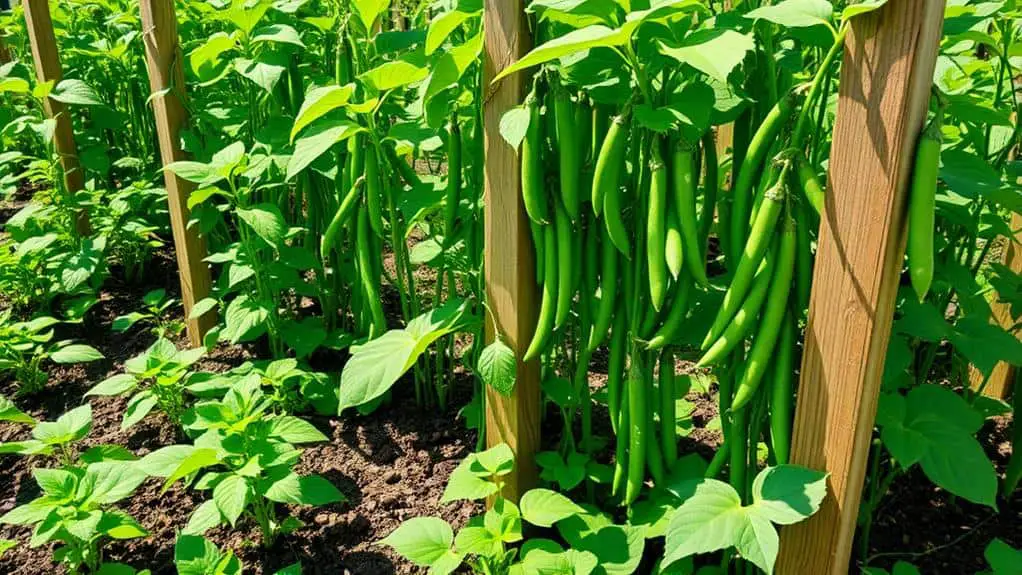
Green beans are a fantastic choice for beginner gardeners looking for quick and rewarding results. These vegetables are known for their fast germination, typically sprouting within 7-10 days. They thrive in full sun and well-drained soil, which makes them perfect for summer planting. Aim to provide a growing environment that's warm and moist to guarantee your green beans flourish.
There are two main types of green beans you can choose from: bush beans and pole beans. Bush beans are compact and don't require support, making them ideal for small spaces. On the other hand, pole beans need trellising for climbing but can produce a larger yield in a vertical space.
One of the great benefits of growing green beans is their ability to fix nitrogen in the soil, enriching the growing environment for other plants. This makes them excellent for interplanting with other vegetables.
Harvesting green beans is straightforward; they're ready to pick when they're firm and snap easily, usually about 50-60 days after planting. Regularly picking your beans encourages continuous production, giving you fresh green beans throughout the growing season.
With these tips, you'll find growing green beans both simple and satisfying.
Carrots
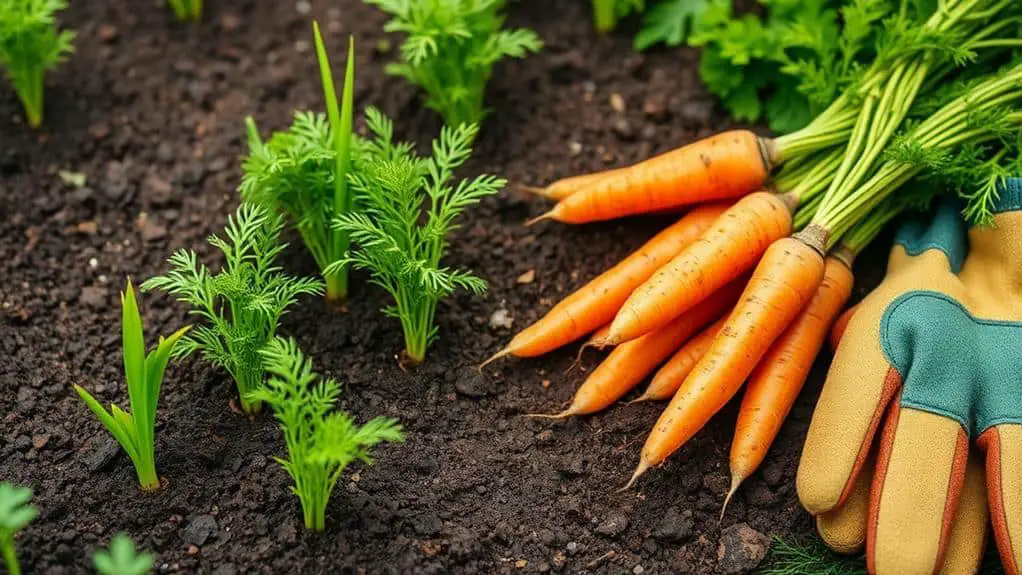
Carrots are one of the easiest vegetables to grow, especially if you provide them with loose, sandy soil and full sun.
You'll want to plant the seeds directly in your garden, making sure to keep the soil consistently moist for the best germination.
With a bit of care and patience, you can enjoy sweet, crunchy carrots in just about 70 days.
Ideal Growing Conditions
To grow vibrant and healthy carrots, start by ensuring your garden has loose, sandy soil that allows their roots to develop fully. Carrots thrive in well-drained soil to prevent rot, which is vital for their growth. They're an easy vegetable to grow, especially if you provide the right conditions from the start.
Carrots prefer full sun but can tolerate light shade, especially in warmer climates. This means you should choose a garden spot that gets plenty of sunlight but won't overheat.
Consistent moisture is essential during germination. Keep the soil moist while the seeds are sprouting, which usually takes 14 to 21 days.
Once your seedlings are about 2-3 inches tall, it's important to thin them out. Proper spacing of 2-4 inches between each plant is key for ideal root development. Carrots are hardy and can even tolerate light frost, which can enhance their sweetness.
Here's a quick checklist to help you remember the ideal growing conditions for carrots:
- Soil: Loose, sandy, and well-drained.
- Sunlight: Full sun to light shade.
- Moisture and Spacing: Keep soil moist during germination, thin seedlings to 2-4 inches apart.
Following these tips will set you on the path to a successful carrot harvest!
Planting and Care Tips
When it comes to planting and caring for carrots, ensuring the right techniques from the beginning can make all the difference. Start by choosing a spot with loose, sandy soil. This type of soil is perfect for carrots because it allows their roots to grow deep and straight. Make sure the soil is at least 12 inches deep.
Sow your carrot seeds directly into the garden. Plant the seeds about ¼ to ½ inch deep and keep the soil consistently moist to help with germination. Carrot seeds usually take 14 to 21 days to sprout.
When your seedlings are a few inches tall, thin them out so they're about 2-3 inches apart. This spacing helps prevent overcrowding, which can lead to healthier growth.
Carrots can handle a bit of frost, so you can plant them in early spring or plan for a fall harvest. They take about 70 days to mature.
Regular watering is essential, especially during dry spells. Keep the soil moist but not waterlogged to avoid splitting and to enhance the sweetness of the carrots.
Harvest and Uses
Once your carrots have matured, usually around 70 days, it's time to enjoy the fruits of your labor. You'll know they're ready to harvest when they reach about 1/2 to 1 inch in diameter. Gently pull them from the soil, taking care not to break the roots.
Carrots are incredibly versatile and can be used in many ways:
- Raw Snacking: Freshly harvested carrots make a crisp and healthy snack. Just wash and peel them, and they're ready to eat.
- Salads and Soups: Chop or grate carrots to add a burst of color and nutrition to your salads. They also add sweetness and texture to soups.
- Cooked Dishes: Carrots can be roasted, steamed, or sautéed, enhancing the flavor and nutritional value of your meals.
For storage, keep your carrots in a cool, dark place. They can stay fresh for several weeks if you store them in a moist environment, like a container with sand.
Nutritionally, carrots are a powerhouse, rich in beta-carotene, fiber, and vitamin K, making them a healthy addition to any diet.
As a beginner gardener, you'll find that growing and harvesting carrots is both rewarding and enjoyable. Happy gardening!
Peas
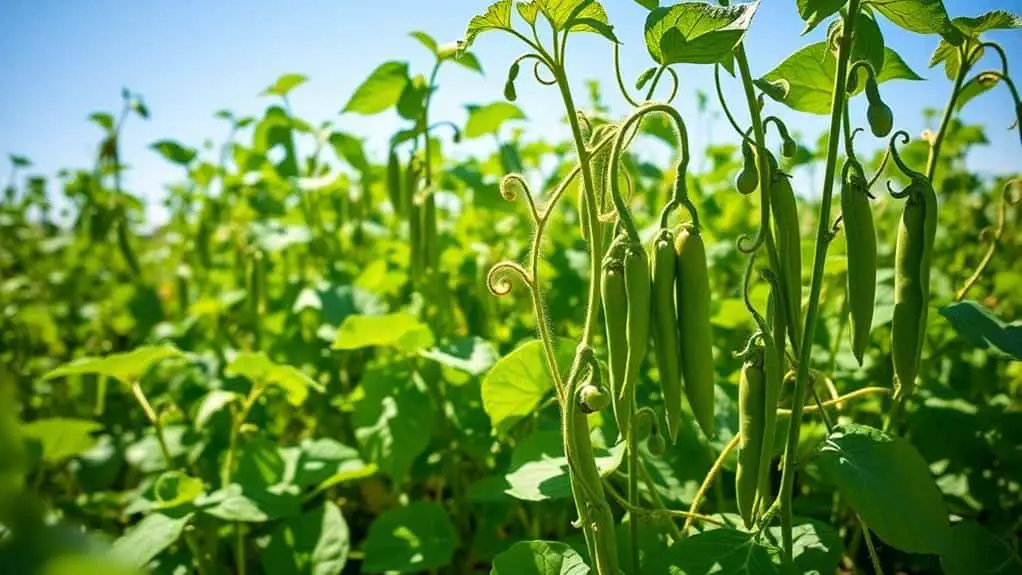
Peas are a fantastic addition to any spring garden, thriving in cool temperatures and ready to be planted as early as two weeks before the last frost. As a cool-season crop, peas love the brisk spring air and will grow best in well-drained soil.
Make certain your soil has a pH between 6.0 and 7.0, which is ideal for their growth. Peas also prefer full sun, but they can tolerate partial shade if needed.
One of the best things about growing peas is that they're nitrogen-fixing plants. This means they enhance soil health by adding nitrogen back into the soil, benefiting any crops you plant afterward.
When planting peas, you'll need to provide support for climbing varieties, which often reach heights of 3-6 feet.
Harvesting peas is straightforward and rewarding. You can start picking them about 60-70 days after planting, once the pods are firm and filled out.
This timing guarantees you get the best flavor from your peas. If you follow these tips, you'll be well on your way to enjoying a bountiful spring harvest. Happy gardening!
Kale
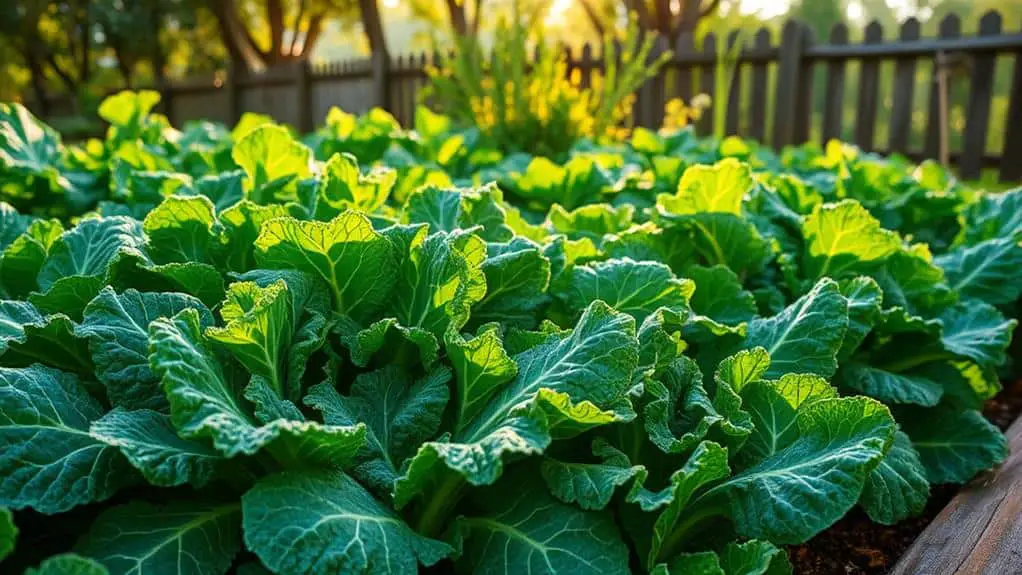
Kale is an incredibly versatile and nutrient-dense leafy green that thrives in cooler temperatures, making it perfect for early spring and fall planting.
It's one of the easiest vegetables to grow, especially for beginner gardeners. Kale is hardy and can tolerate light frost, which can even enhance its sweetness. Plus, you can harvest it multiple times throughout the growing season by picking the outer leaves, letting the inner ones continue to grow.
To get the best results with kale, follow these steps:
- Prepare the Soil: Kale prefers well-drained soil that's rich in organic matter. Adding compost can help improve soil quality.
- Water Regularly: This plant benefits from regular watering to keep the soil moist. Avoid letting the soil dry out completely.
- Choose Your Variety: There are curly, flat, and ornamental types of kale. Each offers different flavors and can add unique aesthetics to your garden.
Tomatoes
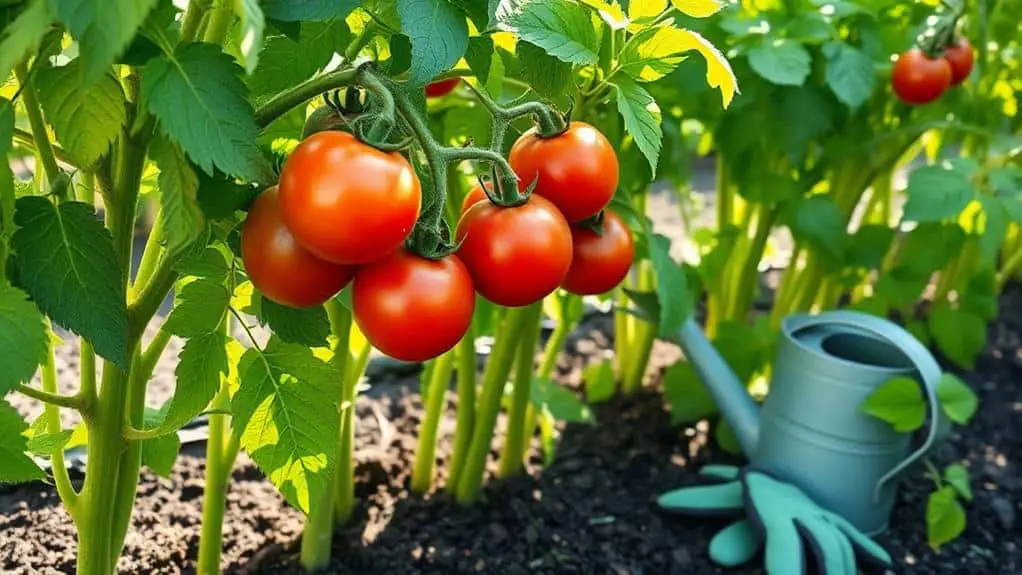
Tomatoes are among the most rewarding vegetables to grow in your garden, offering a versatile array of flavors and uses in the kitchen. They're easy to grow, making them perfect for beginner gardeners. You can start by sowing seeds indoors about six weeks before the last frost or by purchasing young plants from a nursery.
Tomatoes thrive in full sun, needing at least 6-8 hours of sunlight each day. They prefer well-draining, nutrient-rich soil to support their growth. Regular watering is vital, with about 1-2 inches of water per week, keeping the soil consistently moist but not waterlogged.
Here's a quick guide to help you grow tomatoes successfully:
| Requirement | Details |
|---|---|
| Sunlight | Full sun (6-8 hours per day) |
| Soil | Well-draining, nutrient-rich |
| Watering | 1-2 inches per week |
| Support Structures | Stakes or cages for taller varieties |
Support structures like stakes or cages are necessary for taller tomato varieties. These keep your plants upright and prevent damage from wind or heavy fruit. Additionally, there are various tomato types, such as cherry, Roma, and beefsteak, allowing you to choose the best fit for your culinary needs.
Zucchini

Zucchini is a fantastic choice for your garden because it loves warm weather and full sun, making it easy to grow in most conditions.
You'll be amazed at how quickly it matures, usually in about 45 to 55 days, and how much fruit just one plant can produce.
Remember to pick the zucchini when it's about 6-8 inches long to keep the plant producing more and to enjoy it in everything from stir-fries to baked goods.
Ideal Growing Conditions
For those looking to cultivate zucchini, you'll find that these plants truly thrive in warm weather. To guarantee your zucchini grows well, you need to focus on creating the ideal growing conditions.
First, zucchini loves warmth. Make sure your soil temperature is at least 70°F for the best results. Warm soil helps zucchini plants grow and produce more fruit.
Second, they prefer well-drained soil that's rich in nutrients. Aim for a pH level between 6.0 and 7.5. This range supports healthy root development and overall plant health.
Sunlight exposure is another critical factor. Zucchini plants need full sun, which means they should get at least 6-8 hours of sunlight each day. This helps the plants grow strong and produce lots of zucchini.
Regular watering is also essential. Focus on deep watering at the soil level to keep the ground consistently moist. Avoid wetting the leaves to prevent diseases.
Lastly, give your zucchini ample space. Each plant needs about 3 feet of space to grow. This spacing allows for better air circulation and nutrient uptake, which leads to higher yields.
Here are the key points to remember:
- Warm soil (at least 70°F)
- Full sunlight exposure (6-8 hours)
- Regular, deep watering at soil level
Harvesting Tips
When it comes to harvesting zucchini, timing is everything. You'll want to pick your zucchini when they're about 6 to 8 inches long. At this size, they've a tender texture and excellent flavor, perfect for your fresh vegetables.
Regular harvesting every few days is essential. This practice encourages your plant to produce more fruit, ensuring a steady supply of delicious produce.
To harvest, use a sharp knife or pruning shears. Carefully cut the zucchini from the plant, making sure not to damage the stem or leaves. This helps keep the plant healthy and productive.
Avoid letting your zucchini grow over 10 inches. Larger fruits tend to become tough and seedy, which reduces their culinary value.
Once harvested, store your zucchini in the refrigerator. They'll stay fresh for about 4 to 7 days. It's best not to wash them until you're ready to use them, as washing can cause moisture buildup and spoil the produce faster.
Cooking Versatility
Many mightn't realize just how versatile zucchini can be in the kitchen. Whether you're making savory or sweet recipes, this summer squash can do it all. When harvested at a small to medium size, zucchini has a tender texture and mild flavor that fits perfectly into a variety of dishes. Here are some ideas to get you started:
1. Savory Dishes: Zucchini can be sautéed, grilled, or roasted. Try adding it to stir-fries, casseroles, or even slice it thin for salads.
It's also fantastic in Mediterranean cuisine, pairing well with herbs like basil, oregano, and thyme.
2. Sweet Treats: Don't forget about baked goods! Zucchini bread is a classic, but you can also use it in muffins or cakes.
Its mild flavor doesn't overpower sweet recipes, making it a great way to sneak in some veggies.
3. Edible Blossoms: Zucchini blossoms are a gourmet treat. They can be stuffed with cheese, fried, or tossed into salads for a special touch.
You can even spiralize zucchini into noodles as a low-carb pasta substitute. With so many options, you'll find plenty of ways to enjoy your harvest!
Cucumbers
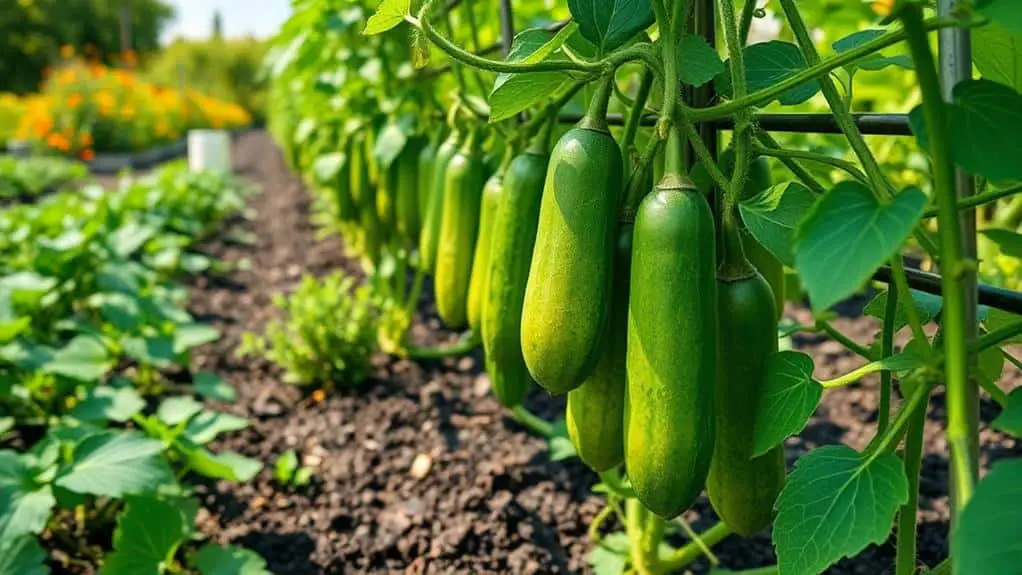
Cucumbers are an ideal choice for your garden if you're looking for a warm-season crop that thrives in well-drained, nutrient-rich soil with full sun exposure.
These warm-season vegetables are pretty straightforward to grow and offer a rewarding harvest. They usually take about 50 to 70 days to mature, making them a relatively quick option for your garden.
Make certain your cucumbers get regular watering, especially during dry spells, to guarantee they stay crisp and juicy. Consistent moisture at the soil level is key.
If space is an issue, consider trellising your cucumbers. This not only saves space but also improves air circulation, reducing the risk of disease.
One of the best parts of growing your own cucumbers is the homegrown flavor. They often taste way better than store-bought varieties, and you can harvest them when they're 6 to 8 inches long.
Whether you're slicing them for salads, pickling them, or just snacking, you'll notice the difference.
Beets

Beets, known for their vibrant colors and nutritional benefits, are a fantastic addition to any garden. They're easy to grow and can be sown directly in the garden from March to July. Beets thrive in well-drained soil with consistent moisture, making them a low-maintenance choice for beginner gardeners.
Here's why beets are a popular choice:
- Versatile Harvest: You can harvest baby beets in about 30 days or let them mature for around 60 days to enjoy larger roots.
- Space-Saving: Beets can be multi-sown, meaning you can plant several seeds together. This allows for staggered harvesting and helps you make the most of your garden space.
- Nutrient-Rich: Beets are packed with nutrients and can be enjoyed in various ways—roasted, pickled, or grated in salads. Plus, their edible greens add both aesthetic appeal and nutritional value to your garden and meals.
When planting beets, guarantee you keep the soil consistently moist and well-drained. This helps the roots develop properly and prevents them from becoming tough.
With their vibrant colors and multiple uses, beets are a wonderful, nutrient-rich vegetable that can enhance both your garden and your diet.
Potatoes
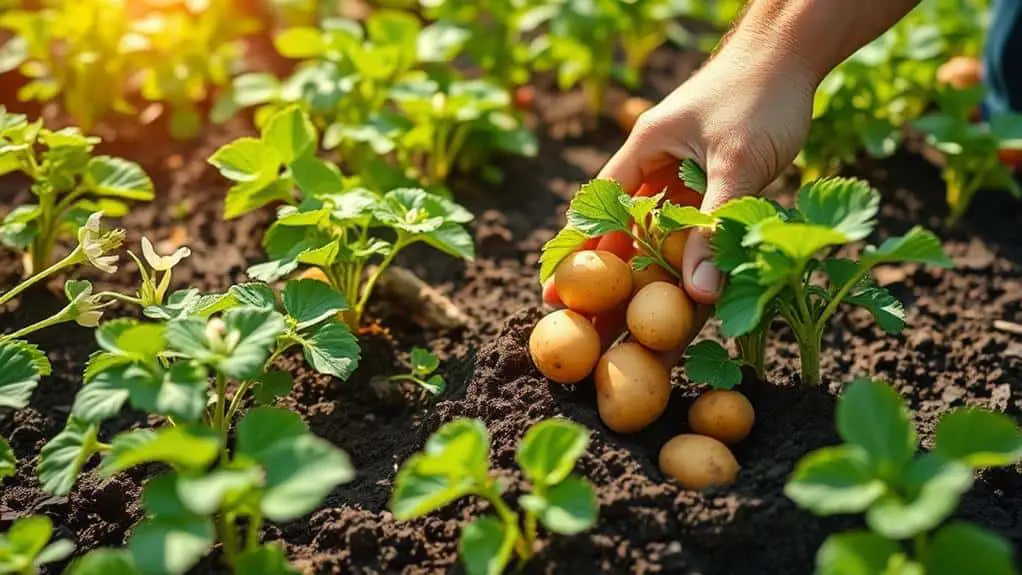
Potatoes are a great choice for beginner gardeners because they're easy to grow and can yield a large harvest.
Using the no-dig planting method, you can simply place seed potatoes on the soil and cover them with mulch, making the process simple and efficient.
When it's time to harvest, gently dig up the tubers as the plant tops turn yellow, and you'll have plenty of potatoes to store and enjoy.
No-Dig Planting Method
Many gardeners find the no-dig planting method for potatoes a game-changer due to its simplicity and effectiveness. This technique involves laying down seed potatoes directly on the soil surface and covering them with layers of organic materials like straw, compost, or grass clippings.
These layers help retain moist soil and suppress weeds, creating a nutrient-rich environment for your potatoes. The no-dig planting method promotes healthier soil structure by preventing soil compaction and preserving beneficial organisms. As a result, you can expect better potato yields.
Here's how you can get started:
- Prepare the Soil: Guarantee the soil has adequate drainage and is rich in nutrients. Potatoes thrive in well-drained, nutrient-rich environments.
- Planting: Lay your seed potatoes directly on the soil surface. Cover them with organic materials. This will help keep the soil moist and provide essential nutrients.
- Maintenance: Regularly water the layers of organic material, especially during dry spells, to maintain moisture levels and encourage growth.
With the no-dig method, harvesting potatoes becomes easier. You can simply remove the organic layer without disturbing the soil, making the collection process cleaner and more efficient.
Give it a try, and you'll be rewarded with a bountiful harvest!
Harvesting and Storage Tips
To guarantee a successful potato harvest, wait until the tops of the plants start to yellow and die back, usually about 2-3 weeks after flowering.
Gently use a garden fork or shovel to lift the tubers from the soil. Be careful not to puncture them, as damaged potatoes can rot during storage.
After harvesting, let the potatoes cure in a cool, dark place for 1-2 weeks. This allows their skins to toughen, which helps extend their storage life.
Curing is an important step to guarantee your potatoes remain fresh for longer periods.
Once cured, store your potatoes in a cool, dark, and well-ventilated area. The ideal temperature is around 45-50°F (7-10°C).
This environment prevents sprouting and decay. It's essential to check stored potatoes regularly and remove any that show signs of spoilage or sprouting.
This practice maintains the quality of the remaining tubers and prevents the spread of rot.
High Yield Potential
Achieving a high yield from your potato crop is rewarding and entirely possible with the right approach. Potatoes have a high yield potential, often producing 2 to 10 times the amount of seed potatoes you plant.
To maximize your harvest, focus on ideal growing conditions. Potatoes thrive in well-drained soil, which allows roots to develop easily. You'll want to keep the soil loose and airy, whether planting in traditional rows or containers.
Consistent moisture is vital, especially during the tuber formation stage, which happens about 6 to 8 weeks after planting. Regular watering guarantees your potatoes grow healthy and strong.
Remember, potatoes offer multiple harvest opportunities. You can start digging up young "new potatoes" early in the season or wait for fully matured potatoes later on.
Here are three steps to boost your potato yield:
- Choose the Right Soil: Make certain it's well-drained and loose.
- Water Regularly: Maintain consistent moisture, especially during tuber formation.
- Try No-Dig Planting: Place seed potatoes on the soil surface and cover with mulch to simplify the process.
Bell Peppers
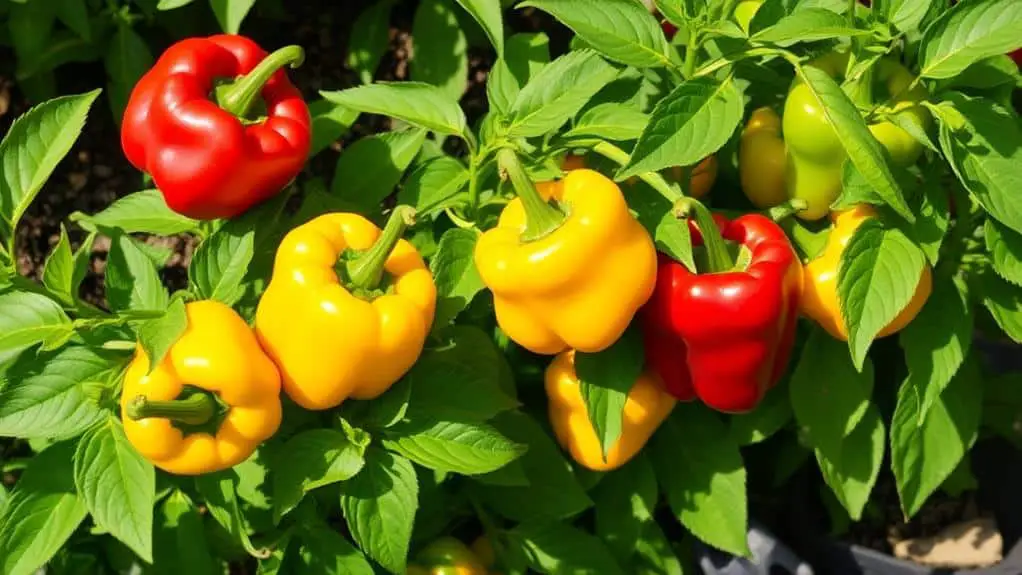
Bell peppers, available in a vibrant array of colors like green, yellow, orange, and red, are both visually appealing and nutritionally rich, boasting high levels of potassium, vitamin C, and vitamin A.
To grow bell peppers successfully, you'll need to guarantee they get full sun and well-draining soil. These plants love sunlight, needing at least 6-8 hours a day. Without enough light, they may struggle to grow and produce fruit.
Start by planting bell pepper seeds indoors 8-10 weeks before the last frost date. Once the danger of frost has passed and the soil temperature reaches at least 70°F, you can transplant them outdoors. Make sure to space the plants properly to allow room for growth.
Regular watering is essential for bell peppers. They prefer consistent moisture but make sure not to overwater, as this can lead to root rot. Check the soil regularly to maintain the right moisture level.
When it's time to harvest, pick bell peppers once they reach full size and the desired color. This stage guarantees they'll be sweet and flavorful.
Store your harvested peppers in the fridge, where they'll stay fresh for up to a week. Happy gardening!
Broccoli

When it comes to easy vegetables to grow, broccoli stands out as a rewarding choice. This nutrient-dense vegetable is perfect for beginner gardeners. It's a cool-season crop, which means it thrives in cooler weather, making it ideal for planting in early spring or late fall.
Broccoli prefers well-drained soil and needs consistent moisture to grow its best. To help your broccoli plants flourish, make certain to space them at least one foot apart. This spacing guarantees proper air circulation and light exposure, which are essential for healthy growth.
Broccoli is quite resilient and can even tolerate light frost, so don't worry if the weather gets a bit chilly.
Here are three key tips to keep in mind:
- Plant in cool seasons: Spring and fall are the best times for broccoli.
- Provide well-drained soil: Verify the soil is well-drained and kept consistently moist.
- Space adequately: Plant seedlings at least one foot apart for proper air circulation.
Broccoli typically matures in under two months. Start by harvesting the main head, then enjoy the flavorful side shoots that follow.
Garlic
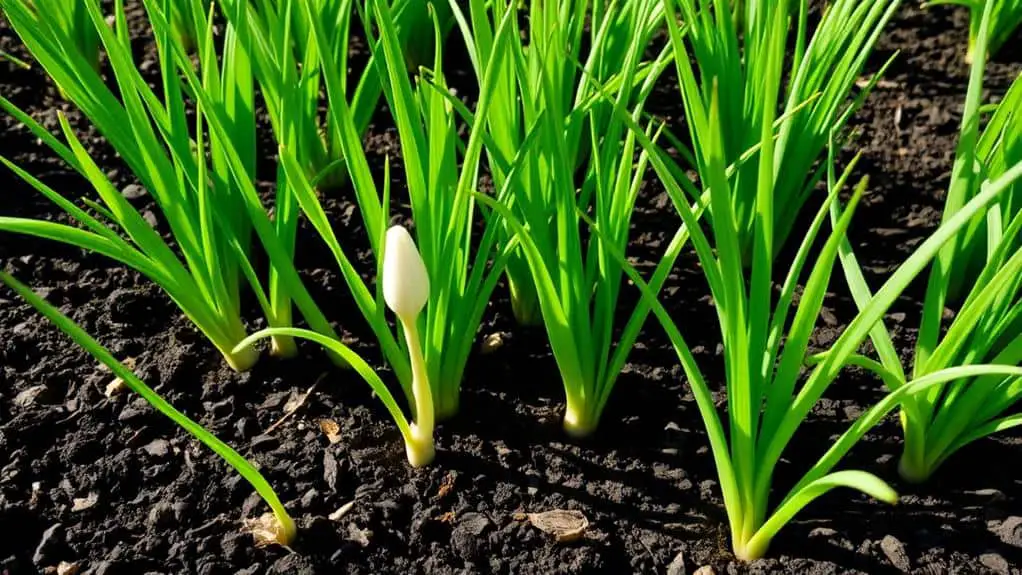
Just like broccoli, garlic is another excellent choice for beginner gardeners looking for an easy-to-grow vegetable. Garlic isn't only simple to plant but also highly rewarding. You can start with individual cloves from a grocery store bulb, making it very accessible.
Plant the cloves in the fall or spring, about 2 inches deep in well-drained soil, with the pointed end facing up. Garlic thrives in full sun and needs consistent moisture. It loves fertile, loose soil enriched with organic matter. This means you should mix compost or other organic materials into your soil before planting.
The growing process is straightforward. After planting, you'll need to wait for about 6 to 8 months for your garlic to mature. You'll know it's harvest time when the foliage turns yellow and starts to brown.
Once you've harvested the garlic, it's important to cure the bulbs. Place them in a cool, dry place for several weeks. This step enhances their flavor and helps them store longer.
Growing garlic can be a delightful experience, providing you with flavorful bulbs and boosting your gardening confidence. So, go ahead and give it a try!
Spring Onions
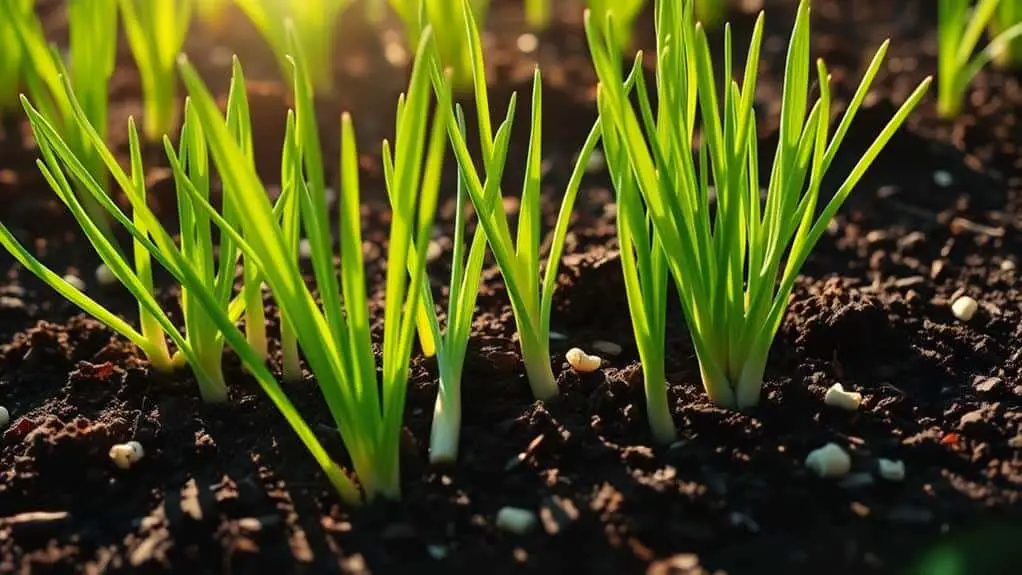
Spring onions are an excellent choice for beginner gardeners due to their ease of growth and versatility in the kitchen. You can sow them directly into well-drained soil or multi-sow for a quicker harvest.
These onions thrive in both full sun and partial shade, which makes them adaptable to various garden conditions. Just make sure the soil stays moist.
One of the great things about spring onions is their quick growth. You can typically harvest them within 8 to 12 weeks. This allows for multiple harvests throughout the growing season, giving you a continuous supply of fresh, mild onion flavor for your dishes.
Here's a quick guide to help you get started:
- Prepare the Soil: Make sure you have well-drained soil. If not, you can mix in some compost to improve drainage.
- Planting: Sow the seeds about 1 inch apart in rows, or multi-sow in clusters for quicker results.
- Harvesting: Once they reach a desirable size, usually within 8 to 12 weeks, you can start harvesting.
Spring onions are versatile in culinary applications, adding a fresh, mild onion flavor to salads, soups, and other dishes.
If you have more than you can use, try pickling the bulbs to enjoy delicious silverskin onions later. Happy gardening!
Frequently Asked Questions
What Vegetables Can a Beginner Gardener Grow?
You can start with lettuce, green beans, radishes, cucumbers, and zucchini. These vegetables are easy to grow, require minimal care, and provide quick, rewarding results. Just follow basic gardening tips, and you'll enjoy a bountiful harvest.
What Vegetables Should I Start Growing First?
You should start with lettuce for its cool-weather resilience and multiple harvests. Green beans and radishes are quick to grow, giving you fast results. Cucumbers and tomatoes are easy too, offering delicious produce with minimal effort.
What Are the Easiest Vegetables to Grow in Your Home Garden?
You should start with radishes, lettuce, and green beans. They're easy to grow and quick to harvest. Cucumbers and zucchini are also great choices, thriving in nutrient-rich soil and sunny spots for abundant yields.
What Is the Quickest Vegetable to Grow?
The quickest vegetable to grow is microgreens. You'll see results in just 10 to 14 days after sowing. They're perfect for those who want fast, fresh produce. Plus, you can grow them indoors or outdoors.
Conclusion
You've got everything you need to start your vegetable garden! These 15 easy options will help you gain confidence and enjoy fresh, homegrown produce. Don't worry if things don't go perfectly at first—gardening is a learning process. Just follow the basics, pay attention to your plants, and you'll see progress. Remember, every gardener started as a beginner, just like you. So, dig in, have fun, and watch your garden grow! You've got this!

